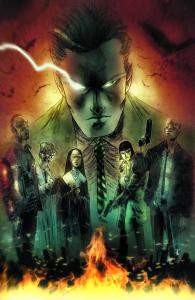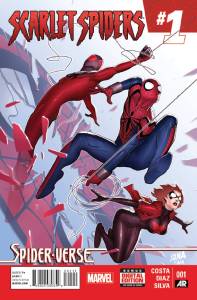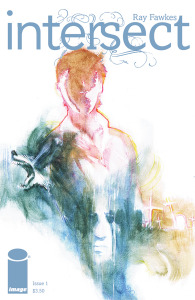Alright, fellow parishoners: now that turkey’s carved, you are stuffed with stuffing, and the cranberry is done with, but we still have plenty to give thanks to for being geeks. And, as always, we’ve got some interesting and diverse titles to showcase! This week’s comics span the universe, the multiverse, and everything in between. And, this week, we’ve got an extensive review from one of our favorite, most groundbreaking writers! We’ve got our faithful congregation to tell us which of the following books are worth buying, or at least worth a tryptophan-induced read by the fireplace. So, without further ado, our extensive and detailed look at…


Everyone grows up being afraid of things that go bump in the night… and someone has to investigate them. That’s the basic tagline of Gotham By Midnight #1, which introduces Jim Corrigan (aka the Spectre), and his motley crew into the New 52. And since we’re on the subject of rhyming onomatopoeia (you’re welcome, Burt Ward!), the sound that this comic makes is a resounding “Thud!!!”. Although, there are a few caveats to accompany that statement. First off, writer Ray Fawkes (Constantine, Trinity of Sin: Pandora), does well in setting the pace of the narrative by driving this first installment, kinda like the pre-credit sequence of a Bond movie. There’s plenty of subtle ambiguity and mystery to the dialogue for me to say “Okay, I get it. I see what you’re all about… Batman’s in this? Slaughter Swamp? Alright, I’ll check out where this is gonna go.”
Now on the counter side of the coin, artist Ben Templesmith… Here’s his caveat: 30 Days of Night was awesome. That being said, I would have enjoyed GBM#1 far more had the color palate been more film noir and less like if Bill Plimpton tried drawing Calvin and Hobbes on LSD. The subtext of the writing was overshadowed by the images coming across a little too cartoonish just when the stakes were reaching their peak. Premature animation, if you will. In any case, there are enough easter eggs and deeper connections to the greater universe for me to come back for at least one more entry. GBM#1 serves its purpose in establishing the series, yet it won’t raise the dead. 3/5 Paranormal Superhero Escapades.


Scarlet Spiders #01, written by Mike Costa and art by Paco Diaz, follows three Spidey clones on a mission to another dimension to stop the Inheritors (an organization of clones bent on inter-dimensional domination). They land in a beautiful city that doesn’t seem evil, but soon they learn the truth. The focus is mainly on Jessica, whose backstory I am looking forward to learning more about.
With some surprise guest appearances from some of our favorite Avengers, and surprises around every corner, this issue is a very fun introduction to the series.
You have your brains (Jessica), your brawn (Kaine), and your lovable comic relief (Ben). The three form a hilarious trio most sitcoms would envy. Not to mention the obligatory shirtless Spidey frame early on. Ladies (and some gents), you know what I’m talking about. I am really looking forward to following this series, as it may be a new favorite. 4.75/5 Web Cartridges.


Matt Fraction (The Invincible Iron Man; The Immortal Iron Fist) and Christian Ward’s (Young Avengers, Infinite Vacation) ODY-C, from Image Comics, is a bold and visually compelling retelling of The Odyssey. While transposing the epic tale (no, the proper, correct use of the word “epic”) to a science fiction setting, Fraction also set about reversing the gender roles. Odysseus here is Odyssia, a warrior princess looking to begin her decade-long return home after a long war in deep space, and the trials and tribulations that attempt to thwart her and her stalwart crew.
The mini-series will undoubtedly follow through the entire epic poem, which is quite exciting, as not only is the story beautifully adapted (once I figured out the structure, and figured out it was a direct adaptation), but the artwork and designs are beautiful as well. Ward’s designs are a beautiful science fantasy pastiche, with unique (and distinct) character designs, and color coding that delineates not only character speech (some speech bubbles are red, or blue, or green, and the color corresponds to specific characters speaking), but that hearken back to the pop science fiction stories and comics on which many of the design elements are based. There are several beautiful splash pages that showcase a wondrous, colorful, watercolored panorama, and which would be at home in a frame above a fireplace or an exposed-brick wall. There is a level of imagination and ingenuity with the design not only of the framing, but of the titular spaceship Odyssia commands, that reminds me of Jodorowsky or a brighter, lighter David Lynch or HR Geiger. It will be interesting to see where the series goes (although, if one simply recalls The Odyssey, one has at least some idea), so long as the artwork and designs continue to be so beautifully rendered. 5/5 Future Fantasy Warrior Queens.
![]()
The Multiversity: Pax Americana #1 is the greatest single issue of a comic book published this year.
Don’t like superheroes? I don’t care. Don’t like DC, Morrison, or Quitely? I don’t care. It’s so good that none of those things matter. Because this is a comic that uses the medium to its fullest, the kind of intense exploration of the comic book form that you wouldn’t really expect from a Big Two comic. At the very least you should read it to see how phenomenal the storytelling is, even if it’s not a story that particularly interests you. This book is meticulous in its devotion to using every part of every panel to its fullest extent; nothing is wasted. Everything has meaning.
Without context, the book is fantastic.
And yet it’s even better with context.
The most obvious entry point involves Watchmen, because Earth-4 (where this story takes place) features the Charlton heroes who were the inspiration for Watchmen. Legend has it that Moore originally intended to use the Charlton heroes, but the nature of the story made DC nervous, so they denied him the characters. There are also a fair amount of visual nods towards Watchmen, particularly shapes melting into the next panel and background action forming the transition to a new scene. Quitely’s always been very good at these types of movements; Eve’s mother spilling her drink on the magazine is detailed enough that we understand that what’s happening is important, but in that panel the focus is on Eve. There’s a beautiful sense that what’s happening around these characters is more important than what’s happening to them.
But viewing Pax Americana through the lens of Watchmen is doing the book a disservice. While Morrison and Quitely keep many of the original trappings that Moore and Gibbons added to the Charlton heroes, these aren’t the same characters. Yes, Nightshade/Silk Spectre is the daughter of a superhero, but this version wants to follow in her mother’s footsteps. This version of the Question isn’t paranoid as they really are out to get him. This Peacemaker is an ultra violent agent of the U.S. government, but he’s also a believer of the fantastic and a big picture thinker.
In other words, this is a mature version of the Charlton heroes that isn’t mired in depression and darkness. Horrifying opening sequence notwithstanding, this is a story a comic book story for adults that isn’t grim or gritty, and that is saying a lot.
It’s saying that we can be better than we were. That we can evolve.
![GOTHAM AFTER MIDNIGHT / SCARLET SPIDERS / ODY-C / MULTIVERSITY - PAX AMERICANA [Reviews]: Busting Down Doors!](https://dcomixologyssl.sslcs.cdngc.net/k/23045/162069/0ea7821356c9d28ad63101bb0baf5c60.jpg?h=77d1d2af5bfb9aef877186240e790930&width=640) The book opens with a bullet to the head and closes with a bullet to the head, but in between there’s only a few pages of any kind of violence. In fact, it’s perhaps the least necessary section in the book, save to expand upon the political reality of modern day Earth-4. But, as the West Wing taught us, political realities aren’t forged in flashy ways, they’re formed in the background, in the shadows. Newly anointed president Harley may think he’s the political force in Pax Americana, but he’s out front; he’s the flash that’s hiding the true power, Captain Atom. But even that isn’t the full story.
The book opens with a bullet to the head and closes with a bullet to the head, but in between there’s only a few pages of any kind of violence. In fact, it’s perhaps the least necessary section in the book, save to expand upon the political reality of modern day Earth-4. But, as the West Wing taught us, political realities aren’t forged in flashy ways, they’re formed in the background, in the shadows. Newly anointed president Harley may think he’s the political force in Pax Americana, but he’s out front; he’s the flash that’s hiding the true power, Captain Atom. But even that isn’t the full story.
So where do you begin in talking about a story that is supposed to have no beginning and no end?
How about the brilliant coloring job by Nathan Fairbairn? Even at its darkest, which is arguably the opening sequence, this book is bright and vibrant. The President has his face blown off in the first few pages and it’s crisp and clear, like a big, bold superhero comic. There’s a two-page spread that features 32 panels detailing 3 different points in time and yet each one has its own distinct time of day conveyed by the colors: day, evening, and night. It’s wonderful and keeps the story lines straight.
Then there’s the sequence where the Question is, well, questioning a criminal. The whole thing is tinted red, in context because of the red light from the giant sign. But it’s also a reference to the Question’s political rant, in which he refers to red as the color power (and how much of that rant is a nod towards the Question’s creator, Steve Ditko?).
It’s almost impossible to talk about the work Quitely has done on this comic without noting how he collaborated with Morrison. The two apparently live close to each other, to the point where Fairbairn posted a picture of the two of them sketching out the last page of the issue together. According to Quitely, this issue marks the first time Morrison had ever supplied him with rough thumbnails which he could either work from or disregard.
And while the mad genius of the panel layouts may have originated from Morrison, their ultimate use and the images that filled them could not have been rendered by anyone but Quitely. I am horrible at discussing art because I honestly lack the vocabulary to do so.
In my eyes, Quitely has the unique ability to create stark images that are still incredibly detailed. There’s a wonderful image of the Peacemaker in the air, preparing to fire the shot that will kill the president. He’s literally floating in the air against Fairbairn’s beautifully colored sky. Peacemaker is drawn with so much detail that you’re drawn to him, creating a contrast with his surroundings that makes the image jump off the page. The same can be said a panel later when we see
the ship Peacekeeper is jumping out of. It’s striking.
Quitely also conveys movement in a way that draws attention to the action without overshadowing the focus of the story. One of the greatest pages in the entire issue features a conversation between Nightshade and her father as they walk down some stairs. That’s it. They walk down stairs. But it’s beautiful. It’s ten panels, seven of which are from the same distance, yet the insertion of those other three panels and the shape and layout of all of them, makes the page a joy to read.
What do I even say about the two page spreads? What do you say about 32 panels covering three different stories that take place during three different points in time, but in the same location, yet are all perfectly clear? Then there’s the juxtaposition of the Peacemaker being tortured and what appears to be his last moments with his wife. Then we have two, back to back two page spreads of the Peacemaker dismantling terrorists. It’s interesting to note that all of the two page spreads feature the Peacemaker in some fashion, perhaps because he’s the most bombastic of the characters.
It would take me years to decipher everything on the page where Harvey understands the secret of algorithm 8. Years.
Which brings me to Grant Morrison’s story. Those who can’t stand Morrison’s work are going to find plenty to hate here, because on at least one level Pax Americana is the epitome of Morrison. While there is a fairly straightforward (for Morrison) story here, there’s an awful lot left to the reader to determine. And it may seem like a cop out, but that’s the point.
Pax Americana is the story of the life of President Harley, starting with his death, ending with the defining moment of his life. We see all the important moments of his life: his assassination, the first time he meets Captain Atom, his formation of Pax Americana, his moment of clarity in the form of algorithm 8, and the day he accidentally shot and killed his father (who happened to be the very first superhero of Earth-4, Yellowjacket). It’s all there on the page. He asks Peacemaker to kill him, he asks Captain Atom to resurrect him, he says he has to atone for something and we even see what that something is. It’s all right there, clear as day, just told backwards.
And, really, of all the things that happen in this single issue, Harley’s story is the one that matters. But let’s come back to that.
Harley’s belief is that his resurrection will usher in a golden age for America, a drastic move made by a man who, because of algorithm 8, can see the future, or at least discern it from patterns. Harley is the Ozymandias analog, the Peter Cannon stand in, yet his plan is the complete opposite of Ozymandias’. If you’re looking for a statement from this comic with regards to Watchmen, here it is. This story believes that resurrection — that life and hope — will save the world. Watchmen believed the only way to save it was to burn it to the ground.
But Harley is never resurrected, because Captain Atom is seemingly destroyed by four scientists who create a black hole in Atom’s head (that would do it). Why do these scientists do this? Why does Atom, who is basically a god, let them? He even tells them he knows what they’re doing. Why does Sarge Steel, whose face is never shown, kill the scientists? And why is Nora, Peacemaker’s girlfriend and the only other person who knows the secret of algorithm 8, murdered? And what the heck does any of this have to do with the rest of this series?
I’ve read and considered a half a dozen theories in the 48 hours since I read Pax Americana for the first time and one or two of them hold up well under scrutiny. But which one is right? The answer is all of them and none and believe me when I say I know how frustrating that sounds.
But the whole point of this issue is that these superhero stories are stuck in a perpetual loop, that the band might change but the song remains the same. It is a story that’s determined by the reader, the ultimate interactive comic. It has to be, because if it clearly gives us any of those answers then it ends. We have the answers, so we’d stop asking questions, and the whole point here is that the questions never end. They can’t, or the story dies. It’s why The Question is the detective in the story, and why everyone else is in the background.
Depending upon how you approach this comic, it’s different every time you read. “All the best stories are,” says President Harley.
So how can I claim that a story with no ending is the best comic of the year? Well, because it has no ending. Do any of these stories have endings? Is Superman over? Did they cancel Spider-man for more than a week? This single issue of Pax Americana is representative of an entire history of a comic book.
And all of that would make this an interesting comic, a wonderfully academic comic, but wouldn’t necessarily make it the best comic of the year. I make that claim because besides everything I just said, the last scene of this comic is heartbreaking.
We’re told that Harley’s father was killed by an intruder, “open and shut case,” according to what Harley told the Peacemaker. We also know that he thinks he deserves to die. “Let the punishment fit the crime,” he told the Peacemaker. We know that he believes in the power of superheroes. We know that he spent a great deal of time sitting by his father’s grave.
Then we see it unfold. We see a boy sneak into a room with a drawing table. His movement tells us he probably shouldn’t be in there and the drawing table harkens back to a few pages back when Harley mentioned his father drew comic books. In a few panels, we know this is a young Harley, sneaking into his father’s study.
The radio is on, or perhaps it’s a TV in the next room. They’re talking about how great Yellowjacket is, how he’s the people’s superhero. The broadcaster quotes JFK ta7lking about peace, the kind of peace that isn’t just a lack of war, but one that offers hope for the future. Young Harley finds clippings of his father’s exploits. He finds a gun. A figure crawls into the house through a window and startles Harley. He shoots the gun without thinking. Kennedy’s quote continues in the background. The bullet hits the man in the head.
Young Harley walks over to the body; he has just killed Yellowjacket, but that’s as much as he knows. He walks over to the body, kneels down, and removes the mask.
“Not merely peace in our time. But peace for all time.” The JFK quote ends as Harley removes the mask. The broadcaster adds “Remember? That was when it all made sense, right?” And the next panel, the final panel, is Harley holding up the domino mask, twisted in the shape of an “8” but with a hold in the center where the bullet went through.
“Dad?”
Harley didn’t just kill the world’s first hero that night; he killed his first hero, too. And he would spend the rest of his life trying to fix it. He would spend the rest of his life trying to create heroes, trying to save the world. But he can’t, because that is a job that never ends.
It’s a story that never ends.
– Kyle Garret
![]()
There’s a lot to be said about The Multiversity: Pax Americana #1. So much so that I want to keep this short. Once you start to dig into Pax Americana it becomes difficult to stop. It is forty pages of comics from some of the most masterful modern creators almost six years in the making. This is a comic book so meticulously designed and carefully crafted that even the most careful of annotations running twice as many pages as the work itself are bound to miss important elements.
The directive with Pax Americana then is not to provide a comprehensive understanding, but to interpret and continue interpreting. First you may discover a story about the power of the comics form, then one about the infinite effects of violence, then one about post 9/11 politics in America. Of course, if you only focus on these facets, you might miss the strict denouncement of gun violence or the saddening reverie on time’s endless march or the revelation that the realities we construct in fiction return to affect reality. The ideas like mobius loop that is the symbol for infinity are endless.
This infinite dissection and reconstruction is not an easy one to begin. Pax Americana is demanding of its readership. It is not here to feed you ideas or emotions, you must be prepared to discover them. The intellectual challenge of unfolding this comic and learning how and why it has been constructed provides thoughts and feelings far deeper and profound than the ordinary musings found in most paper pamphlets. There is a high bar for entry, one that will deter some readers, but they are the faint of heart. Everything you need to understand is in the text, but you must be prepared to challenge yourself in order to experience it.
I can’t tell you how or why to experience Pax Americana. It is something that defies definition in that it can be defined forwards and backwards and chronologically and as forty separate pieces and in a million different way. It is a mystery box that reveals a new layer every time one is removed. It is something that must be experienced in order to be understood, then re-experienced in order to be understood anew. It is a perfect comic book and one that simply must be read.
– Chase Magnett


@onemyke
Intersect, the new title from Image Comics written and drawn by Ray Fawkes (Constantine, Trinity of Sin: Pandora) is so unique, in every way, that objective criticism is almost impossible. Having said that, Intersect might be the only example of a piece of art that succeeds at what it’s intending to do so well that it almost hurts it. The art of the book is painted in a beautifully, impressionist way that gives more to the emotions running through atmosphere of the world rather than the imagery of the world itself. Various shades of dark green and red color in the eerily ambiguous figures of the creatures that inherit this nightmarish place that rains blood. The panels themselves bleed into one another in a way that makes a few pages seem like they could be an abstract collection of disparate images that have been combined to form one big painting. The whole thing is disorienting in a way that is so easily frustrating that it almost seems like Fawkes did this by design.
The story is of no help, either. No question about the story that begins with “why” could really be answered after reading this first issue, and only a handful of “what”s are really revealed. So far, Intersect seems to be a story about four various entities possessing one body, fighting to navigate said body in whatever direction they think is right, while a flesh-eating creature gives chase. The only relatable part of the narrative are the personalities of the different entities that inherit the body. They’re as emotional, motivated, and developed as non-corporeal-possessing people are. Yet, as familiar as they are as characters, the way that the entities interact with one another is somewhat surreal. At times they share the same speech bubbles, and at times they’re drawn as two separate figures from the body they inhabit. Sometimes their bodies seem to lie within their host’s body. On top of it all, there’s an undefined narrator providing their own thoughts. It can easily feel like a chore to decipher what is being said by whom, but when combined with the otherworldly painted art an ironically outer-bodily feeling permeates every layer of Intersect and makes it a title that cannot be easily dismissed. 3.5/5 Inner Demons.
![GOTHAM AFTER MIDNIGHT / SCARLET SPIDERS / ODY-C / MULTIVERSITY - PAX AMERICANA [Reviews]: Busting Down Doors! GOTHAM AFTER MIDNIGHT / SCARLET SPIDERS / ODY-C / MULTIVERSITY - PAX AMERICANA [Reviews]: Busting Down Doors!](https://geekshavegame.com/wp-content/uploads/2014/11/15d6fed3d540dd4408b24276889fd334.jpg)

![GOTHAM AFTER MIDNIGHT / SCARLET SPIDERS / ODY-C / MULTIVERSITY - PAX AMERICANA [Reviews]: Busting Down Doors!](https://dcomixologyssl.sslcs.cdngc.net/k/23045/162069/5f306a17674090f2973561c062cf980a.jpg?h=a59a21012333f0441cff04bd42a98f69&width=640)
![GOTHAM AFTER MIDNIGHT / SCARLET SPIDERS / ODY-C / MULTIVERSITY - PAX AMERICANA [Reviews]: Busting Down Doors!](https://dcomixologyssl.sslcs.cdngc.net/k/23045/162069/f896e726e87231e9ba10e8b54252954d.jpg?h=afc3e42c4136f055ea9a48c5f57380eb&width=640)
